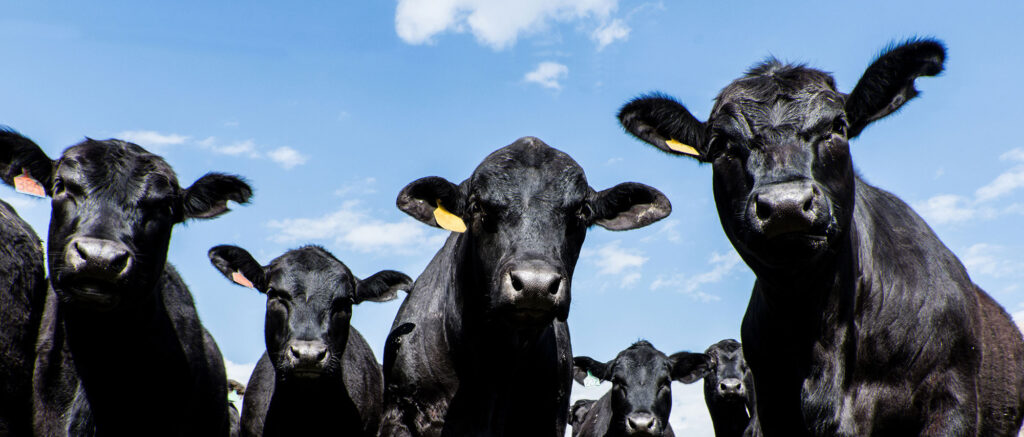3 Considerations for successful feed testing in beef cattle herds
• Posted in Articles
Terry Quam, beef producer at Margda Angus Farm
When it comes to the successful management of livestock and ensuring health and productivity in your beef herd, small details can make all the difference. One critical aspect of herd management often overlooked is feed testing. Producers who are not testing their feed may unknowingly waste resources and jeopardize the reproductive health and body condition of their herd. Feed testing is an affordable investment that not only improves cost-efficiency but is crucial for effective livestock management.

By analyzing feed nutritional content, producers and the nutritionists they work with can make informed decisions on the dietary requirements of their herd. Here are three considerations for successful feed testing:
1. Looks can be deceiving
When it comes to your feed ingredients, looks can be deceiving. Oftentimes, tests can reveal unexpected findings. For instance, seemingly picture-perfect hay may fall short in terms of crude protein and energy, requiring additional supplementation to fill the nutritional gaps. Whether you grow your own feed ingredients or purchase them from a local supplier, it’s always a good idea to re-evaluate nutritional levels when a new feed ingredient is incorporated into the diet.
Feed tests measure critical parameters such as crude protein, mineral content, energy levels and other vital nutrients.1 Local resources such as feed mills, universities and extension services can assist in finding suitable facilities. The turnaround times for results is typically within 48 hours, allowing farmers to make timely adjustments to their cattle diets.
How often should you test your feed? It can vary depending on the crop. For example, different cuts of alfalfa hay – first, second or third crop – can have varying protein content and volume, requiring more frequent testing. It’s recommended to test at least 10 bales from each batch to determine their volume and nutrient content.2
2. Herd goals are key to designing proper rations
Mutual trust plays a significant role in the collaboration between cattle producers and their nutritionists. To better help your nutritionist develop feed rations tailored to your operation’s unique needs, discuss your herd goals and monitor progress often.
At Margda Angus farms, our nutritionist is a key partner in helping us define our goals and tailor our rations to meet them. Working with our nutritionist, feed test results serve as a blueprint for tailoring rations. We’re able to use this data to build a ration with precise quantities of different feed ingredients, supplements and minerals needed daily, essentially offering a dietary prescription for cattle.
Most producers know cows have specific calorie and energy requirements to meet their dietary needs to withstand environmental challenges while nursing calves, preparing for rebreeding and preserving body condition.3 A goal of ours is to ensure we’re giving our females the nutrition they need to build ideal body condition scores. This not only helps with successful calving, but helps to improve rebreeding rates as well. Incorporating whole cottonseed into our cattle rations has helped our operation achieve these goals.
3. Whole cottonseed is a superfood
Whole cottonseed is widely known as a triple-nutrient ingredient containing fat, fiber and protein,4 and an ingredient beef producers can rely on to fill nutritional gaps discovered through feed tests.
The 23% crude protein and 20% crude fat in whole cottonseed5 contribute to net energy needs, enabling the cows to maintain their reproductive health and body condition.6 The high fiber content of whole cottonseed helps support rumen function and digestive health.7 Whole cottonseed is also a valuable component in preconditioning cows for calving, which leads to a uniform calving window, improving calf health and consistency.
When built as part of total mixed ration, whole cottonseed may reduce the need for traditional roughages in the mix, along with reduced protein and fat supplementation.8
While some producers like to keep their rations close to the vest, I’d like to share three pieces of advice for a productive beef cattle herd. First, feed test often and work with your trusted nutritionist to determine the best feed ingredients for your ration. Second, familiarize yourself with the nutritional needs of your herd and pay close attention to your net energy and protein levels. Lastly, consider using whole cottonseed to address specific dietary shortcomings. Here at Margda Angus Farms, we’ve been able to raise our high-quality purebred Angus herd and market our genetics through our annual on-farm production sale each fall. This is a success I have chalked up to prioritizing feed testing and finding unique feed ingredients to add to our rations.
In today’s highly competitive and high-stakes industry, where every dollar and nutrient matters, the meticulous balance of nutritional needs has never been more critical. Reducing risks and cutting costs, while delivering the best products possible is the best way forward for modern livestock production. Whole cottonseed, guided by the insights gained through diligent feed testing and conversations with your nutritionist, is a powerful tool for achieving these goals.
Reach out to your nutritionist about feed testing resources and incorporating whole cottonseed into your beef cattle ration or visit wholecottonseed.com to learn more.
1 Rabsy R, Martin J. (2007). Understanding feed analysis. UNL Beef. Available at: https://beef.unl.edu/learning/feedanalysis.shtml.
2 Mississippi State University Extension (2020). Hay Testing and Understanding Forage Quality. Available at: https://extension.msstate.edu/sites/default/files/publications/publications/P2539_web.pdf.
3 Feeding for Rebreeding. Oregon State University Extension. (2021). Available at: https://extension.oregonstate.edu/animals-livestock/beef/feeding-rebreeding.
4 Kellogg, D.W., Pennington, J.A., Johnson, Z.B. and Panivivat, R. (2001). Survey of management practices used for the highest producing DHI herds in the United States. J Dairy. Sci. Vol. 84, Supplement E120-127. doi: 10.3168/-jds.S0022-0302(01)70206-8.
5 National Research Council. (2001). Nutrient Requirements of Dairy Cattle: Seventh Revised Edition, 2001. Washington, DC: The National Academies Press. https://doi.org/10.17226/9825.
6 Comerford, J.W. (2014). Added fat in the ration of beef cows to enhance reproduction. Pennsylvania State University. Available at: https://extension.psu.edu/added-fat-in-the-ration-of-beef-cows-to-enhance-reproduction.
7 Stewart, L. and Rossi, J. (2010). Using cotton byproducts in beef cattle diets. Bulletin 1311. The University of Georgia and Ft. Valley State University, the U.S. Department of Agriculture and counties of the state cooperating. Available at: http://cottonpickin.tamu.edu/General%20Production/Georgia%20Cotton%20Byproducts%20for%20Beef%20Cattle%20B%201311_2.pdf.
8 Parish J. (2022). Fiber in beef cattle diets. Mississippi State University Extension. Available at: https://extension.msstate.edu/sites/default/files/publications/publications/P2489_web.pdf.

